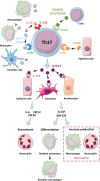Th17 CD4+ T-Cell as a Preferential Target for HIV Reservoirs
- PMID: 35197986
- PMCID: PMC8858966
- DOI: 10.3389/fimmu.2022.822576
Th17 CD4+ T-Cell as a Preferential Target for HIV Reservoirs
Abstract
Among CD4+ T-cells, T helper 17 (Th17) cells play a sentinel role in the defense against bacterial/fungal pathogens at mucosal barriers. However, Th17 cells are also highly susceptible to HIV-1 infection and are rapidly depleted from gut mucosal sites, causing an imbalance of the Th17/Treg ratio and impairing cytokines production. Consequently, damage to the gut mucosal barrier leads to an enhanced microbial translocation and systemic inflammation, a hallmark of HIV-1 disease progression. Th17 cells' expression of mucosal homing receptors (CCR6 and α4β7), as well as HIV receptors and co-receptors (CD4, α4β7, CCR5, and CXCR4), contributes to susceptibility to HIV infection. The up-regulation of numerous intracellular factors facilitating HIV production, alongside the downregulation of factors inhibiting HIV, helps to explain the frequency of HIV DNA within Th17 cells. Th17 cells harbor long-lived viral reservoirs in people living with HIV (PLWH) receiving antiretroviral therapy (ART). Moreover, cell longevity and the proliferation of a fraction of Th17 CD4 T cells allow HIV reservoirs to be maintained in ART patients.
Keywords: CD4-positive T cells; HIV infections; HIV reservoir; T-helper 17 cells; lymphocytes; mucosal immunology.
Copyright © 2022 Renault, Veyrenche, Mennechet, Bedin, Routy, Van de Perre, Reynes and Tuaillon.
Conflict of interest statement
The authors declare that the research was conducted in the absence of any commercial or financial relationships that could be construed as a potential conflict of interest.
Figures




References
-
- Cosmi L, Cimaz R, Maggi L, Santarlasci V, Capone M, Borriello F, et al. . Evidence of the Transient Nature of the Th17 Phenotype of CD4+CD161+ T Cells in the Synovial Fluid of Patients With Juvenile Idiopathic Arthritis. Arthritis Rheumatol (2011) 63(8):2504–15. doi: 10.1002/art.30332 - DOI - PubMed
Publication types
MeSH terms
Substances
LinkOut - more resources
Full Text Sources
Research Materials

